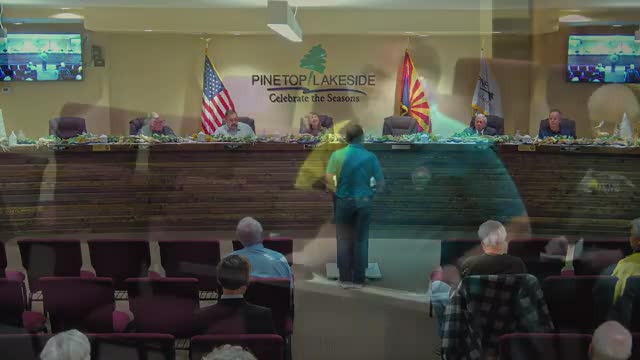Traffic study finds local volumes and speeds within expected ranges; council takes no action
January 02, 2025 | Lakeside, Navajo County, Arizona
This article was created by AI summarizing key points discussed. AI makes mistakes, so for full details and context, please refer to the video of the full meeting. Please report any errors so we can fix them. Report an error »

Pinetop Lakeside — The town council heard a traffic study on Jan. 2, 2025, that concluded vehicle volumes and speeds on Navajo Lane, Apache Lane and Claudia Lane are generally consistent with a residential neighborhood and do not require immediate engineering changes, the study presenter told the council.
The presentation, delivered by Matt (traffic study presenter), summarized a seven-day counter-and-camera study that the town commissioned to answer residents’ complaints about cut-through traffic and speeding between State Route 260 and Woodland Lake Road. The study used pneumatic tube counters and cameras to measure volumes, vehicle classes, travel times and speeds; the consultant reported results for specific movement pairs such as Navajo-to-Jaeger and Apache-to-Jaeger.
The study found low cut-through rates: Navajo to Summerhaven and similar short links showed cut-through percentages near 1.5 percent in some comparisons; the larger Navajo-to-Jaeger segment recorded 15 cut-through trips in one full day, and Apache-to-Jaeger recorded 19 trips on its highest day. Average speeds reported were below the posted limits: Apache averaged 21.9 mph, Navajo averaged about 23.0 mph and Claudia averaged about 18 mph. The presenter said the 85th-percentile speeds were not more than 5 mph over posted limits, a common threshold for consideration of engineering changes.
"The analysis indicated less than 15% of the total traffic was cut-through between Woodland Road and SR 260. I would not suggest that we do anything with this," Matt said during the presentation.
Several council members and residents questioned the findings. Resident Anik Demol, who led a petition calling for action on Navajo and Apache, said the numbers understates local experiences and suggested recent enforcement activity may have temporarily reduced speeding during the study period. "I'm very disappointed in the results of this study because in my estimate ... it's a gross understatement," Demol said at the podium.
Police input came from Commander Wilkie, who described enforcement discretion for speed enforcement and said Arizona law requires officers to judge whether a speed is "reasonable and prudent" for the area; he noted tolerance levels vary by roadway type and are lower in school zones. "It's always officer discretion," he said.
Councilor Phillips asked about study costs and equipment. Matt said the study was performed by a contractor (United Civil) using rented equipment; the seven-day study cost about $7,000. Matt recommended monitoring the corridor over time and repeating study work if development or travel patterns change.
During public exchange, the presenter and councilors discussed parcel counts and local housing density; the presenter said the number of parcels in the study area was over 300, which helps explain the volume of local crossover traffic. Councilors and residents agreed to keep the issue under observation and to return for further study if conditions change.
The council did not take formal action to change traffic controls after the presentation.
The presentation, delivered by Matt (traffic study presenter), summarized a seven-day counter-and-camera study that the town commissioned to answer residents’ complaints about cut-through traffic and speeding between State Route 260 and Woodland Lake Road. The study used pneumatic tube counters and cameras to measure volumes, vehicle classes, travel times and speeds; the consultant reported results for specific movement pairs such as Navajo-to-Jaeger and Apache-to-Jaeger.
The study found low cut-through rates: Navajo to Summerhaven and similar short links showed cut-through percentages near 1.5 percent in some comparisons; the larger Navajo-to-Jaeger segment recorded 15 cut-through trips in one full day, and Apache-to-Jaeger recorded 19 trips on its highest day. Average speeds reported were below the posted limits: Apache averaged 21.9 mph, Navajo averaged about 23.0 mph and Claudia averaged about 18 mph. The presenter said the 85th-percentile speeds were not more than 5 mph over posted limits, a common threshold for consideration of engineering changes.
"The analysis indicated less than 15% of the total traffic was cut-through between Woodland Road and SR 260. I would not suggest that we do anything with this," Matt said during the presentation.
Several council members and residents questioned the findings. Resident Anik Demol, who led a petition calling for action on Navajo and Apache, said the numbers understates local experiences and suggested recent enforcement activity may have temporarily reduced speeding during the study period. "I'm very disappointed in the results of this study because in my estimate ... it's a gross understatement," Demol said at the podium.
Police input came from Commander Wilkie, who described enforcement discretion for speed enforcement and said Arizona law requires officers to judge whether a speed is "reasonable and prudent" for the area; he noted tolerance levels vary by roadway type and are lower in school zones. "It's always officer discretion," he said.
Councilor Phillips asked about study costs and equipment. Matt said the study was performed by a contractor (United Civil) using rented equipment; the seven-day study cost about $7,000. Matt recommended monitoring the corridor over time and repeating study work if development or travel patterns change.
During public exchange, the presenter and councilors discussed parcel counts and local housing density; the presenter said the number of parcels in the study area was over 300, which helps explain the volume of local crossover traffic. Councilors and residents agreed to keep the issue under observation and to return for further study if conditions change.
The council did not take formal action to change traffic controls after the presentation.
View full meeting
This article is based on a recent meeting—watch the full video and explore the complete transcript for deeper insights into the discussion.
View full meeting
